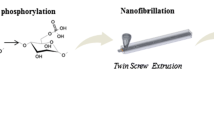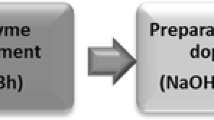Abstract
In this study, cellulosic fibres (bleached Kraft pulp of Eucalyptus), pre-treated with Deep Eutectic Solvents (DES), have been microfibrillated using a twin-screw extruder (TSE). DES pre-treatment was performed for 4 h at 100 °C with three eutectic systems: betaine hydrochloride–urea, choline chloride–urea and choline chloride–monoethanolamine. DES-treated fibres were first refined (PFI-mill) and then passed four times through the TSE whose advantage is to obtain microfibrillated cellulose (MFC) at high solid content (20%). Several characterisations were carried out before and after TSE to evaluate the effects of these treatments on both the fibres and MFC. The Young’s modulus of the obtained nanopapers was, for instance, around 6 GPa. Extruded-MFC were compared to those produced by ultrafine grinding. The comparison showed that the ultrafine grinding allows obtaining MFC of better quality. This result can be attributed to the slipping phenomenon occurred during extrusion.







Similar content being viewed by others
Abbreviations
- BHCl:
-
Betaine hydrochloride
- CC:
-
Choline chloride
- CrI:
-
Crystallinity index
- DP:
-
Degree of polymerisation
- EF:
-
Eucalyptus fibres
- M:
-
Monoethanolamine
- MFC:
-
Microfibrillated cellulose
- QI*:
-
Simplified quality index
- TSE:
-
Twin-screw extruder
- U:
-
Urea
References
Siró I, Plackett D (2010) Microfibrillated cellulose and new nanocomposite materials: a review. Cellulose 17:459–494. https://doi.org/10.1007/s10570-010-9405-y
Cousins SK, Brown RM (1995) Cellulose I microfibril assembly: computational molecular mechanics energy analysis favours bonding by van der Waals forces as the initial step in crystallization. Polymer 36:3885–3888. https://doi.org/10.1016/0032-3861(95)99782-P
Spence KL, Venditti RA, Rojas OJ et al (2011) A comparative study of energy consumption and physical properties of microfibrillated cellulose produced by different processing methods. Cellulose 18:1097–1111. https://doi.org/10.1007/s10570-011-9533-z
Abdul Khalil HPS, Davoudpour Y, Islam MdN et al (2014) Production and modification of nanofibrillated cellulose using various mechanical processes: a review. Carbohyd Polym 99:649–665. https://doi.org/10.1016/j.carbpol.2013.08.069
Boufi S, Gandini A (2015) Triticale crop residue: a cheap material for high performance nanofibrillated cellulose. RSC Adv 5:3141–3151. https://doi.org/10.1039/C4RA12918K
Nechyporchuk O, Belgacem MN, Bras J (2016) Production of cellulose nanofibrils: a review of recent advances. Ind Crops Prod 93:2–25. https://doi.org/10.1016/j.indcrop.2016.02.016
Besbes I, Alila S, Boufi S (2011) Nanofibrillated cellulose from TEMPO-oxidized eucalyptus fibres: effect of the carboxyl content. Carbohyd Polym 84:975–983. https://doi.org/10.1016/j.carbpol.2010.12.052
Isogai A, Saito T, Fukuzumi H (2011) TEMPO-oxidized cellulose nanofibers. Nanoscale 3:71–85. https://doi.org/10.1039/C0NR00583E
Saito T, Kimura S, Nishiyama Y, Isogai A (2007) Cellulose nanofibers prepared by TEMPO-mediated oxidation of native cellulose. Biomacromol 8:2485–2491. https://doi.org/10.1021/bm0703970
Saito T, Nishiyama Y, Putaux J-L et al (2006) Homogeneous suspensions of individualized microfibrils from TEMPO-catalyzed oxidation of native cellulose. Biomacromol 7:1687–1691. https://doi.org/10.1021/bm060154s
Chaker A, Boufi S (2015) Cationic nanofibrillar cellulose with high antibacterial properties. Carbohyd Polym 131:224–232. https://doi.org/10.1016/j.carbpol.2015.06.003
Liimatainen H, Suopajärvi T, Sirviö J et al (2014) Fabrication of cationic cellulosic nanofibrils through aqueous quaternization pretreatment and their use in colloid aggregation. Carbohyd Polym 103:187–192. https://doi.org/10.1016/j.carbpol.2013.12.042
Henriksson M, Henriksson G, Berglund LA, Lindström T (2007) An environmentally friendly method for enzyme-assisted preparation of microfibrillated cellulose (MFC) nanofibers. Eur Polymer J 43:3434–3441. https://doi.org/10.1016/j.eurpolymj.2007.05.038
Pääkkö M, Ankerfors M, Kosonen H et al (2007) Enzymatic hydrolysis combined with mechanical shearing and high-pressure homogenization for nanoscale cellulose fibrils and strong gels. Biomacromol 8:1934–1941. https://doi.org/10.1021/bm061215p
Sirviö J, Hyypiö K, Asaadi S et al (2020) High-strength cellulose nanofibers produced via swelling pretreatment based on a choline chloride–imidazole deep eutectic solvent. Green Chem 22:1763–1775. https://doi.org/10.1039/C9GC04119B
Hong S, Yuan Y, Li P et al (2020) Enhancement of the nanofibrillation of birch cellulose pretreated with natural deep eutectic solvent. Ind Crops Prod 154:112677. https://doi.org/10.1016/j.indcrop.2020.112677
Liu S, Zhang Q, Gou S et al (2021) Esterification of cellulose using carboxylic acid-based deep eutectic solvents to produce high-yield cellulose nanofibers. Carbohyd Polym 251:117018. https://doi.org/10.1016/j.carbpol.2020.117018
Li W, Xue Y, He M et al (2021) Facile preparation and characteristic analysis of sulfated cellulose nanofibril via the pretreatment of sulfamic acid-glycerol based deep eutectic solvents. Nanomaterials 11:2778. https://doi.org/10.3390/nano11112778
Kwon G-J, Bandi R, Yang B-S et al (2021) Choline chloride based deep eutectic solvents for the lignocellulose nanofibril production from Mongolian oak (Quercus mongolica). Cellulose 28:9169–9185. https://doi.org/10.1007/s10570-021-04102-3
Yu W, Wang C, Yi Y et al (2021) Direct pretreatment of raw ramie fibers using an acidic deep eutectic solvent to produce cellulose nanofibrils in high purity. Cellulose 28:175–188. https://doi.org/10.1007/s10570-020-03538-3
Rol F, Belgacem MN, Gandini A, Bras J (2019) Recent advances in surface-modified cellulose nanofibrils. Prog Polym Sci 88:241–264. https://doi.org/10.1016/j.progpolymsci.2018.09.002
Hietala M, Rollo P, Kekäläinen K, Oksman K (2014) Extrusion processing of green biocomposites: compounding, fibrillation efficiency, and fiber dispersion. J Appl Polym Sci. https://doi.org/10.1002/app.39981
Ho TTT, Abe K, Zimmermann T, Yano H (2015) Nanofibrillation of pulp fibers by twin-screw extrusion. Cellulose 22:421–433. https://doi.org/10.1007/s10570-014-0518-6
Suzuki K, Okumura H, Kitagawa K et al (2013) Development of continuous process enabling nanofibrillation of pulp and melt compounding. Cellulose 20:201–210. https://doi.org/10.1007/s10570-012-9843-9
Navarchian AH, Jalalian M, Pirooz M (2015) Characterization of starch/poly(vinyl alcohol)/clay nanocomposite films prepared in twin-screw extruder for food packaging application. J Plast Film Sheeting 31:309–336. https://doi.org/10.1177/8756087914568904
Dhaval M, Sharma S, Dudhat K, Chavda J (2020) Twin-screw extruder in pharmaceutical industry: history, working principle, applications, and marketed products: an in-depth review. J Pharm Innov. https://doi.org/10.1007/s12247-020-09520-7
Uitterhaegen E, Evon P (2017) Twin-screw extrusion technology for vegetable oil extraction: a review. J Food Eng 212:190–200. https://doi.org/10.1016/j.jfoodeng.2017.06.006
Heiskanen I, Harlin A, Backfolk K, Laitinen R (2011) Process for Production of Microfibrillated Cellulose in an Extruder and Microfibrillated Cellulose Produced According to the Process. WO2011051882 (A1), May 5, 2011
Rol F, Karakashov B, Nechyporchuk O et al (2017) Pilot-scale twin screw extrusion and chemical pretreatment as an energy-efficient method for the production of nanofibrillated cellulose at high solid content. ACS Sustainable Chem Eng 5:6524–6531. https://doi.org/10.1021/acssuschemeng.7b00630
Rol F, Banvillet G, Meyer V et al (2018) Combination of twin-screw extruder and homogenizer to produce high-quality nanofibrillated cellulose with low energy consumption. J Mater Sci 53:12604–12615. https://doi.org/10.1007/s10853-018-2414-1
Rol F, Saini S, Meyer V et al (2019) Production of cationic nanofibrils of cellulose by twin-screw extrusion. Ind Crops Prod 137:81–88. https://doi.org/10.1016/j.indcrop.2019.04.031
Rol F, Vergnes B, El Kissi N, Bras J (2020) Nanocellulose production by twin-screw extrusion: simulation of the screw profile to increase the productivity. ACS Sustain Chem Eng 8:50–59. https://doi.org/10.1021/acssuschemeng.9b01913
Abbott AP, Capper G, Davies DL et al (2003) Novel solvent properties of choline chloride/urea mixtures. Chem Commun 0:70–71. https://doi.org/10.1039/B210714G
Suopajärvi T, Sirviö JA, Liimatainen H (2017) Nanofibrillation of deep eutectic solvent-treated paper and board cellulose pulps. Carbohyd Polym 169:167–175. https://doi.org/10.1016/j.carbpol.2017.04.009
Mnasri A, Dhaouadi H, Khiari R et al (2022) Effects of Deep Eutectic Solvents on cellulosic fibres and paper properties: Green “chemical” refining. Carbohyd Polym. https://doi.org/10.1016/j.carbpol.2022.119606
Naderi A, Lindström T, Sundström J (2015) Repeated homogenization, a route for decreasing the energy consumption in the manufacturing process of carboxymethylated nanofibrillated cellulose? Cellulose 22:1147–1157. https://doi.org/10.1007/s10570-015-0576-4
Mnasri A, Khiari R, Dhaouadi H, et al (2022) Acidic and alkaline deep eutectic solvents to produce high aspect ratio microfibrillated cellulose. Submitted to be published in Bioresource Technology
Desmaisons J, Boutonnet E, Rueff M et al (2017) A new quality index for benchmarking of different cellulose nanofibrils. Carbohyd Polym 174:318–329. https://doi.org/10.1016/j.carbpol.2017.06.032
Serpa Guerra AM, Gómez Hoyos C, Velásquez-Cock JA et al (2020) Effect of ultra-fine friction grinding on the physical and chemical properties of curcuma (Curcuma longa L.) suspensions. J Food Sci 85:132–142. https://doi.org/10.1111/1750-3841.14973
Baati R, Magnin A, Boufi S (2017) High solid content production of nanofibrillar cellulose via continuous extrusion. ACS Sustain Chem Eng 5:2350–2359. https://doi.org/10.1021/acssuschemeng.6b02673
Rol F (2019) Prétraitements de la cellulose pour une nanofibrillation par extrusion. Thesis, Université Grenoble Alpes (ComUE)
Mohamed IO, Ofoli RY, Morgan RG (1990) Modeling the average shear rate in a co-rotating twin screw extruder. J Food Process Eng 12:227–246. https://doi.org/10.1111/j.1745-4530.1990.tb00052.x
Suparno M, Dolan KD, Ng PKW, Steffe JF (2011) Average shear rate in a twin-screw extruder as a function of degree of fill, flow behavior index, screw speed and screw configuration. J Food Process Eng 34:961–982. https://doi.org/10.1111/j.1745-4530.2009.00381.x
Acknowledgements
This work was financially supported by the “PHC Utique” program of the French Ministry of Foreign Affairs and Ministry of higher education, research and innovation and the Tunisian Ministry of higher education and scientific research in the CMCU project number TN 18G1132//FR 39316VF. LGP2 is part of the LabEx Tec 21 (Investissements d’Avenir—grant agreement n°ANR-11-LABX-0030) and of PolyNat Carnot Institute (Investissements d’Avenir—grant agreement n° ANR-16-CARN-0025-01). This research was made possible thanks to the facilities of the TekLiCell platform funded by the Région Rhône-Alpes (ERDF: European regional development fund). The authors would like to thank thank Thierry Encinas from CMTC—Grenoble, France for the XRD analysis, Bertine Khlifi from LGP2 for SEM observations and Maxime Terrien from LGP2 for the help in using the twin-screw extruder.
Author information
Authors and Affiliations
Corresponding author
Ethics declarations
Conflict of interest
The authors declare no conflict of interest. Ramzi Khiari is Guest Editor of the Special Issue "Lignocellulose at multiscale: preparation characterization".
Ethics approval and consent to participate
Not applicable.
Consent for publication
Not applicable.
Rights and permissions
Springer Nature or its licensor (e.g. a society or other partner) holds exclusive rights to this article under a publishing agreement with the author(s) or other rightsholder(s); author self-archiving of the accepted manuscript version of this article is solely governed by the terms of such publishing agreement and applicable law.
About this article
Cite this article
Mnasri, A., Khiari, R., Dhaouadi, H. et al. High Content Microfibrillated Cellulose Suspensions Produced from Deep Eutectic Solvents Treated Fibres Using Twin-Screw Extruder. Chemistry Africa 6, 2297–2307 (2023). https://doi.org/10.1007/s42250-022-00511-4
Received:
Accepted:
Published:
Issue Date:
DOI: https://doi.org/10.1007/s42250-022-00511-4




